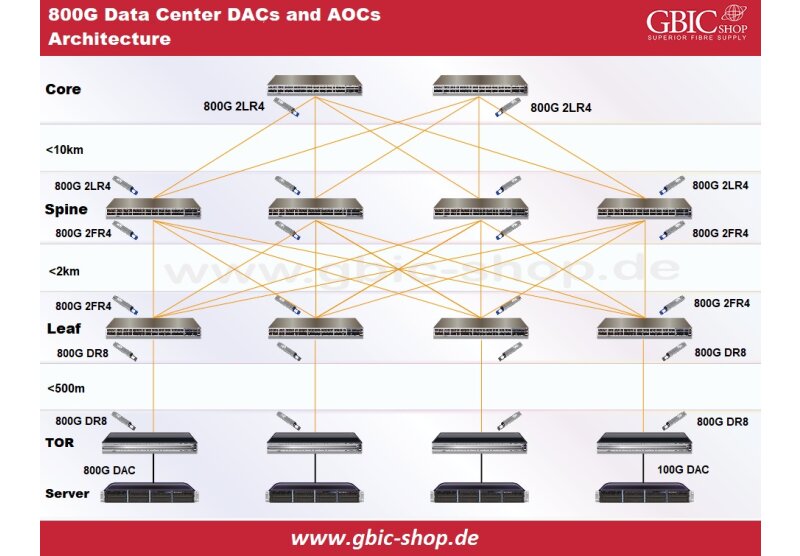Due to technological progress, data centers are undergoing rapid development. Although 100 Gigabit and 400 Gigabit data centers are already widespread, there is a growing trend towards the emergence of 800 Gigabit data centers. The need for effective and dependable cable connections has heightened because of the ever-increasing need for fast data transfer. This article presents various cabling options for 800 Gigabit data centers, including AOCs, DACs, and fiber optic cables.
Solutions for Data Center AOCs and DACs weighing 800G
Direct-attach cables consist of Passive Copper Cable, Active Copper Cable (ACC), and Active Electrical Cable (AEC). These cables are more cost-effective than fiber cables and help minimize the expenses of data centers. Active Optical Cables are smaller and lighter than DACs. They also have minimum bit error rates and can transmit data over longer distances. We commonly use AOCs and DACs to connect network cards, servers, switches, supercomputers, data centers, and cloud computing over short distances.

800G DAC
The increase in the number of large and highly advanced data centers has resulted in a significant boost in the power capability of Individual Server Racks and a decrease in the distance of vertical cabling. Hence, we widely use DAC cabling solutions in 800 Gigabit data centers to establish connections between servers in the same rack. These solutions utilize passive copper, eliminating the need for extra power while ensuring reliable connectivity. DAC has two branches, Direct Attach, and Breakout, available for the form factors QSFP-DD and OSFP.
The 800 Gigabit DAC allows for hot plugging, low power usage, and the ability to bend at small angles for flexible cabling. It provides several benefits for data center cabling, including high stability, space-saving, cost-effectiveness, and efficient heat dissipation. These DACs smoothly combine with switches, servers, and routers, guaranteeing network layout adaptability and networking equipment integration.

800G AEC/ACC
When transmission rates are high, the damage to copper cables becomes more significant, and it becomes impossible to meet the required interconnect length.ACC utilizes the Redriver Chip Architecture to modify the amplification at the receiving end by employing CTLE equalization. This process resembles an active cable as it amplifies an analog sign. Although AEC utilizes the Retimer Chip Design, it serves multiple purposes. It not only enhances and equalizes the transmission and reception ends, but it also modifies the signal at the reception end. We also use AEC and ACC to connect the TOR and server. They make patching more accessible and provide a cost-efficient solution for short connections, enabling faster transmission with greater bandwidth capacity.
800G AOC
The 800 Gigabit AOC is a perfect fit for cloud environments and distributed data centers as it enhances data transfer capacity, reduces delays, and consumes less power. Moreover, using VCSEL upon the technology PAM4 DSP enhances efficiency and decreases expenses and intricacy. The 800 Gigabit AOC currently in the market offers speeds of up to 800 Gigabits per second when used for direct connections within a range of 100 meters. It also allows a single 800 Gigabits per second interface to connect to two 400 Gigabit QSFP-DD modules within one branch cable setup. The branch wire is perfect for linking new switches operating at 800 Gigabits per second to current ports operating at 400Gbps without needing any extra conversion or mapping.
800G Data Centers can Benefit from Optical Cable Solutions.
800G optical cables offer better performance and efficiency for fast data transmission than AOCs and DACs, making them ideal for excessive-density cabling solutions. Fiber cables offer clear benefits regarding reduced delay, energy efficiency, and extended transmission range, guaranteeing a more consistent and dependable link for long-range requirements.
MTP/MPO Optical Cables
MTP patch cables come in various core sizes, including eight, twelve, sixteen, and twenty-four. Among these options, the twelve-fiber MTP OM4 cable is an ideal choice for data center cabling due to its ability to save space and manage cables effectively. On the other hand, the sixteen-fiber MTP Trunk Cable is perfect for direct connections with 800 Gigabit OSFP XDR8 and 800 Gigabit QSFP-DD and OSFP optics. The MPO/MTP cabling solution provides data centers with excessive density, dependability, and versatility. We can use it to establish connections between the core, leaf-level, and spine platforms. This product includes plug-and-play functionality, simple management, great flexibility, and durability, and is compatible with 100G, 400G, and 800G upgrades. It is the perfect choice for modern data centers requiring 800G cabling. Additionally, the MTP® connectors from US Conec adhere entirely to the standards of MPO and offer superior performance compared to Generic MPO connectors.
Uniboot Fiber Optic Patch Cables
The Uniboot cable allows transmitting two fibers through just one cable, which helps decrease the cable's overall size during routing. It utilizes a VSFF (minimal form factor) connector and is compatible with 200, 400, and 800G communication. Additionally, it offers a 1.5 times higher fiber cabling density than the traditional Duplex LC connector. This type of fiber optic cable is ideal for densely packed fiber connections in data centers that operate at speeds of 200, 400, and 800G, which require saving space and alleviating issues related to cable management. Furthermore, these cables are also more compact and lightweight, which makes them easier to install and maintain. As a result, they contribute to improved network performance. The image below displays the highlighted connector of the Uniboot cables.
Conclusion
When setting up an 800 Gigabit data center, it is essential to carefully evaluate the cables’ different types and their unique properties. Various 800G cabling options provide exceptional benefits, and we should select them based on the network’s specific needs. By choosing suitable types of cables and considering factors like bandwidth, expenses, and distance, the data centers can ensure smooth operations at speeds of 800G by offering the required support and connectivity.
 English
English
 Deutsch
Deutsch
 Espaniol
Espaniol










